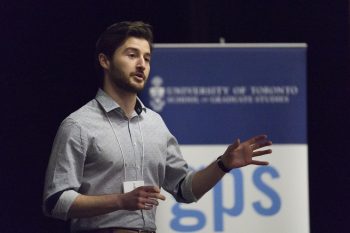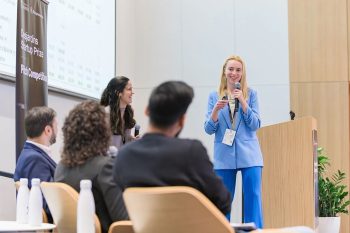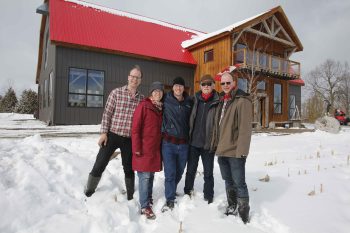“In 1990, we had a horrible death in the subway where a blind woman fell in front of a train,” said Susan Reed Tanaka, Manager of Engineering with the Toronto Transit Commission (TTC).
Standing in the Great Hall of Hart House at the University of Toronto, Tanaka explained how this fatal incident sparked an initiative to make the TTC safer for the visually impaired. The search for a solution led to a collaboration between the CNIB (formerly, Canadian National Institute for the Blind), the TTC and visually impaired subway users.
And, on April 16, that continuing search brought Tanaka to the Praxis II Showcase, a full-day event where first-year U of T Engineering Science students pitched ideas to enhance the safety of TTC stations.
One team – consisting of students Paul Deng, Tristan Laidlow, Cody Tian and Shafquat Arefeen – designed a tactile map they hoped to install at key locations throughout subway stations. The map uses raised symbols marking the locations of doors, stairs and other obstacles on a simplified layout of the subway station to help the visually impaired build a mental image of their surroundings. For these students, a surprise came when Tanaka expressed her interest in their design.
“She wants to get in contact with us to further our solution and work alongside the TTC. Which is amazing,” said Arefeen. “It’s surreal, in a way.”
Jason Foster, co-instructor of the Praxis II course and Senior Lecturer in the Division of Engineering Science, was pleased, but not necessarily surprised, by this development.
“It is important for our students to realize that even in first year they can, through their efforts, have influence,” he said.
Improving the navigability of transit stations, however, was just one of eight issues tackled by the fledgling U of T Engineers presenting at this year’s showcase, now in its seventh year. Other teams, 67 in all, worked to help apartment dwellers grow their own food, increase the safety of wintertime bicycling, and keep raccoons out of the city’s Green Bin compost containers, among other projects.
“What we’re trying to do is bring a balance between solving the right problem, and solving the problem right,” said Foster.
He said the course encourages students to look for local community issues that can be addressed through engineering. The course stresses scientific rigor, design quality and creativity, but also stresses that presentation and communication skills are fundamental aspects of the design process — an emphasis that certainly helped students during the showcase.
Across the room from Deng, Laidlow, Tian, and Arefeen’s poster, Nichole He faced down the bright lights of an OMNI Television camera to explain her team’s retractable vacuum-pad attachment designed to improve the stability of the walkers commonly used by senior citizens.
“Two months ago, I probably couldn’t have stood in front of a camera and presented,” said He. “I feel more confident.”
In recapping their design, the unexpected media treatment, and their experiences as first-year Engineering Science students, He’s teammate, Afiq Asri, locked on to what may just be the underlying ethos of the Praxis II program.
“Everything can be engineered,” said Asri, “if you have the proper framing and you apply the right judgment and decisions.”
Read coverage of this year’s Praxis II Showcase in The Toronto Star or listen to an interview on CBC Radio’s Metro Morning .



